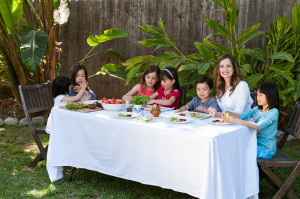
A hungry child can be a sign of a growing child. As a child grows and develops their calorie needs increase. Foods have a purpose for growing children –to provide needed nutrients to keep their bodies free of disease and growing healthy. Choose foods that are easily recognized as whole foods –ones without a long list of ingredients. Be sure to include fruits, veggies and beans for their fight-o-chemical plant power. Avoid giving too many empty, unnecessary calories from foods that have refined flours like crackers (NOT made from 100% whole grains or that contain added sugar) cookies snack foods and fruit chews.
Make sure to have regular meals. Sometimes kids will choose play time over meal time. So having a regular schedule will help them get in a rhythm of being hungry at meal times and eating a balanced healthy meal. This way, they avoid grazing through the day which can be easily misinterpreted as your child always being hungry.
Hunger can also be a sign of boredom, excitement, and sadness. So ask your child if he or she is really hungry or if something else is on his/her mind.
Here are some other tips to help address all-day hunger:
Quench the Thirst:
When a child is thirsty, they may mistake their thirst for hunger. So encourage water before snacks and meals.
- Have your child pick out a reusable water bottle. Be sure to fill it up often and encourage them to drink water before they feel thirsty! Make sure your water bottle is BPA free and does NOT contain Phthalates.
- Make sure they are drinking water at school or when playing outside.
- Role model by drinking adequate fluids
- Invest in a carbon water filter to ensure safe drinking water
- Make your own flavored water with orange, lemon or cucumber slices.
- Consider making fruit flavored ice tea. I make a pitcher of herbal cranberry and orange teas in the morning to enjoy throughout the day. Children like the fruity flavored water.
- Add fresh mint to water to give it a cool refreshing taste.
Boost Fiber:
Overall, higher fiber foods will keep your child satisfied and feeling full for longer.
- Whole grain products have fiber. When choosing grains or bread products aim to include those that are 100% whole grain. Choose these over white products because of their high fiber content and because whole grain products still have the natural plant compounds attached to the fiber, which prevent disease.
- Also look for cereals that have at least 5 grams of fiber or more per serving and are lower in sugar. Choose cereals with <12g sugar per 120 calories (which is usually around 1cup of cereal).
- Whole fruits and vegetables are also loaded with fiber!
Go Lean with Protein:
Good sources of protein can also help with feeling full.
- A good rule of thumb is to always include some sort of healthy protein in meals and snacks.
- Good protein includes lean meats, low-fat dairy products such as milk, yogurt, or cottage cheese, low fat cheese, eggs, bean dip like hummus or black bean dip, or peanut butter.
Snack Smart
Great snack ideas that will keep your child full and satisfied include:
- Banana Pops: Stick a popsicle in a banana. Thinly spread peanut butter or almond butter on the banana and roll in chopped nuts. Place banana in freezer for 3 hours. Enjoy your banana pop!
- Tex-Mex popcorn: Spice up your popcorn! Melt ¼ cup olive oil with 1 tbsp taco seasoning to make a healthy tex-mex mix. Pop popcorn and pour tex-mex mix over popcorn.
- Very Berry Yogurt: Low-fat vanilla yogurt with mixed berries and whole-grain cereal. Greek yogurt may help your child feel fuller longer –just be sure to choose low-fat for kids older than 2 years. Mix together for a perfect filling treat!
Get more great ideas on feeding your kids from SuperKids Nutrition Expert Interviews with Diane Fagan on kids eating habits, Kate Scarlata on eating slow in a fast world and Jo-Ann Heslin on feeding challenges and raising a healthy family.



